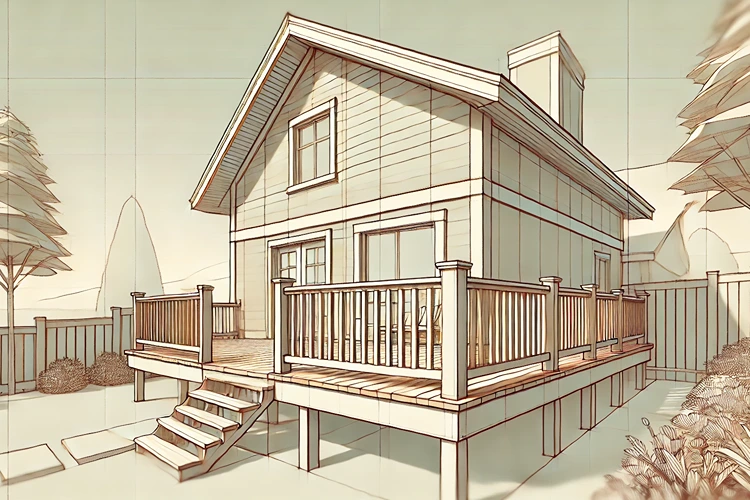Understanding the Structure of a Typical Rectangular Deck

A typical rectangular deck is one of the most popular designs for outdoor spaces. It’s simple, functional, and offers a timeless appeal that fits seamlessly with most home styles. But what exactly makes up a rectangular deck? In essence, it is a flat, horizontal surface supported by a framework, usually constructed of wood, composite, or metal materials. This structure is often connected to the back of a house, extending the living area into the outdoors.
Understanding the structure of a typical rectangular deck involves looking at several key components. These include the deck frame, the decking boards, and the support system. Each part plays a critical role in ensuring the deck’s durability, stability, and overall aesthetic. A well-built rectangular deck provides a safe and comfortable outdoor space for activities such as dining, lounging, and entertaining.
Key Components of a Rectangular Deck
The structure of a rectangular deck is straightforward but requires precision in its construction to ensure longevity and safety. The primary components include:
- Deck Frame: The frame is the skeleton of the deck. It is usually constructed from pressure-treated wood or metal and consists of beams, joists, and ledger boards.
- Decking Boards: These are the surface boards that form the top layer of the deck. They are laid horizontally across the frame and can be made from various materials, including wood, composite, and PVC.
- Support System: This includes posts, footings, and sometimes additional bracing that ensures the deck remains level and can support the intended weight.
How the Deck Frame Is Constructed
The deck frame is the backbone of the entire structure. It provides the support needed for the decking boards and ensures the deck is level and secure. The frame is typically built using pressure-treated lumber because of its resistance to moisture and pests. This material is ideal for outdoor structures that need to withstand the elements over time.
The construction begins with the ledger board, which is attached to the house and serves as the main anchor point for the deck. Joists are then attached to the ledger board and span out towards the opposite end of the deck. These joists are spaced evenly to provide consistent support for the decking boards that will be laid on top. Finally, beams are placed perpendicular to the joists, adding additional stability to the structure.
Why Pressure-Treated Lumber Is Preferred for Deck Frames
Pressure-treated lumber is the go-to material for deck frames due to its durability and resistance to environmental factors. It is treated with chemicals that help protect the wood from decay, insects, and moisture, making it ideal for long-term use in outdoor environments. Moreover, pressure-treated wood is cost-effective, providing a balance between affordability and durability.
Helpful Hint:
When constructing a deck, consider the climate in your area. In regions with high humidity or frequent rain, using pressure-treated wood for the frame can significantly extend the life of your deck by preventing rot and insect damage.
Decking Boards: The Surface of Your Deck
Decking boards are the most visible part of your deck and play a significant role in its overall appearance and functionality. These boards come in various materials, each with its advantages and drawbacks. The choice of decking material can influence the deck’s durability, maintenance requirements, and aesthetic appeal.
Wood is the traditional choice for decking boards, with options ranging from cedar and redwood to exotic hardwoods like ipe. Composite decking, made from a mix of wood fibers and plastic, has gained popularity due to its low maintenance and resistance to rot. PVC decking is another alternative that offers high durability and a wide range of colors and styles.
How to Choose the Right Decking Material
When selecting decking material, consider factors such as budget, maintenance, and the desired look of your deck. Wood offers a natural beauty that is hard to replicate, but it requires regular maintenance to prevent weathering. Composite and PVC decking are more expensive upfront but offer a longer lifespan with minimal upkeep. Additionally, these materials are often more resistant to fading, staining, and scratching than traditional wood.
Stats:
According to a recent study, composite decking accounts for approximately 19% of the decking market in the United States, and its popularity is steadily increasing due to its low maintenance requirements and long-lasting durability.
Material Comparison for Rectangular Decks
| Material | Cost | Maintenance | Durability | Environmental Impact |
|---|---|---|---|---|
| Pressure-Treated Wood | $$ | High | 10-15 years | Moderate |
| Composite Decking | $$$ | Low | 25-30 years | Low (if recycled materials are used) |
| PVC Decking | $$$$ | Very Low | 30+ years | Low |
| Exotic Hardwood | $$$$ | Moderate | 25-40 years | High (due to deforestation concerns) |
The Support System: Keeping Your Deck Sturdy
The support system of a rectangular deck is crucial for its safety and longevity. This system includes posts, footings, and occasionally additional bracing, depending on the deck’s height and size. The posts are vertical elements that transfer the weight of the deck to the ground, while the footings are the concrete bases that support these posts.
Properly installed footings are essential to prevent the deck from shifting or settling over time. They must be set below the frost line in colder climates to prevent movement caused by the freeze-thaw cycle. The posts are typically made from pressure-treated wood and are anchored to the footings using metal connectors. In some cases, additional bracing may be added to reinforce the structure, particularly in areas with high winds or heavy loads.
Why Footing Depth Matters
Footing depth is a critical factor in deck construction. If the footings are not deep enough, the deck can become unstable, leading to potential safety hazards. In colder climates, the footings should extend below the frost line to prevent frost heave, which can lift the deck and cause structural damage. The depth of the footings will vary based on local building codes and soil conditions, but a minimum depth of 12 inches is commonly recommended.
Deck Railings: Essential for Safety and Style
The railings on a rectangular deck are not just a safety feature; they also contribute significantly to the deck’s overall aesthetic. Railings are typically required by building codes for decks that are more than 30 inches above the ground. They prevent falls and can also enhance the visual appeal of the deck. The style, material, and height of the railings can be customized to match the design of your home and your personal preferences.
Railings are usually constructed from wood, metal, or composite materials. Wooden railings offer a traditional look but require regular maintenance to prevent decay. Metal railings, such as those made from aluminum or steel, provide a more modern appearance and are highly durable. Composite railings combine the benefits of both wood and metal, offering a low-maintenance option with a wide range of styles and colors.
Choosing the Right Railing Material
When selecting a railing material, consider factors such as the deck’s location, the overall design of your home, and the level of maintenance you’re willing to commit to. For instance, if your deck is in a coastal area, metal railings might be a better choice due to their resistance to saltwater corrosion. On the other hand, if you prefer a more natural look, wooden railings could be more suitable, provided you’re prepared for the upkeep.
Helpful Hint:
Consider adding lighting to your deck railings for both safety and ambiance. Solar-powered lights are a great option as they are energy-efficient and easy to install, providing a soft glow that enhances the deck’s usability during the evening.
Stairs: Accessing Different Levels Safely
Stairs are a critical component of any elevated deck, providing access to different levels of your outdoor space. The design and placement of the stairs can greatly influence the overall functionality and appearance of your deck. Stairs are typically constructed from the same material as the deck to ensure a cohesive look. The number of steps and their width will depend on the height of the deck and the available space.
Building stairs requires careful planning to ensure they meet safety standards. The rise (the vertical height of each step) and the run (the horizontal depth of each step) must be consistent to prevent tripping hazards. Handrails are also an essential safety feature, particularly for longer staircases. They provide support and can be designed to match the deck’s railings for a uniform look.
Best Practices for Building Deck Stairs
When building deck stairs, it’s crucial to follow local building codes, which dictate the minimum and maximum dimensions for the rise and run. A common guideline is a rise of 7.25 inches and a run of 10 inches, which provides a comfortable and safe step. Additionally, ensure that the stairs are wide enough to accommodate foot traffic, with a minimum width of 36 inches recommended for most residential decks.
Weatherproofing: Protecting Your Deck from the Elements
One of the key aspects of maintaining a rectangular deck is ensuring it is well-protected from the elements. Weatherproofing involves applying protective coatings to the deck’s surface and using materials that are resistant to moisture, UV rays, and temperature fluctuations. Regular maintenance, such as sealing the deck, can significantly extend its lifespan and keep it looking new.
Different materials require different types of protection. For example, wood decks should be sealed every few years to prevent water damage and warping. Composite decks are generally more resistant to the elements but can still benefit from occasional cleaning and a UV-protective coating. Metal components, like railings, should be inspected regularly for signs of rust and treated accordingly.
Stats:
A study by the North American Deck and Railing Association found that regular maintenance can extend a deck’s life by up to 25%, highlighting the importance of weatherproofing and routine care.
Adding Personal Touches: Customizing Your Deck
While the structure of a typical rectangular deck is fairly standardized, there are numerous ways to customize it to fit your personal style and needs. From built-in seating and planters to pergolas and outdoor kitchens, the possibilities are endless. These additions not only enhance the functionality of the deck but also make it a more inviting space for relaxation and entertainment.
When planning custom features, consider how they will integrate with the existing structure and the overall aesthetic of your home. Built-in seating, for example, should be placed in areas that maximize views and sun exposure. Adding a pergola can provide shade and create a cozy atmosphere, while outdoor kitchens are perfect for those who enjoy cooking and dining outdoors.
Ideas for Customizing Your Deck
- Built-In Seating: Create a comfortable and functional space by incorporating benches along the perimeter of the deck.
- Planters: Integrate greenery into your deck by adding built-in planters that can house flowers, herbs, or small shrubs.
- Pergolas: Add a pergola to provide shade and structure, perfect for hanging plants or outdoor lighting.
- Outdoor Kitchens: Elevate your outdoor living by installing a kitchen area complete with a grill, sink, and storage.
By customizing your rectangular deck, you can transform it from a basic outdoor platform into a personalized retreat that reflects your lifestyle and preferences.
Advantages and Disadvantages of a Rectangular Deck
Pros
- Simplicity in design allows for easy construction and maintenance.
- Maximizes usable space, providing a large area for outdoor activities.
- Cost-effective compared to more complex deck shapes and designs.
- Rectangular decks are versatile and can easily accommodate various additions like pergolas or seating areas.
- Ideal for standard-sized materials, reducing waste during construction.
Cons
- Less visually interesting compared to multi-level or curved deck designs.
- May not fit well with irregularly shaped or sloped yards without additional landscaping.
- Limited design creativity, which might not appeal to homeowners looking for a unique outdoor space.
- Potential for water pooling in corners if not properly sloped during construction.
- Can feel less integrated with the natural landscape compared to more organic shapes.
FAQs
Wrapping Up
Understanding the structure of a typical rectangular deck is crucial for anyone looking to enhance their outdoor space. From the foundational frame to the final touches, each component plays a vital role in creating a durable and functional deck. A rectangular deck not only provides a practical outdoor area but also adds value and aesthetic appeal to your home. By choosing the right materials, following best practices in construction, and considering both the pros and cons, you can ensure your deck stands the test of time. For homeowners interested in a straightforward, versatile design, the rectangular deck is an excellent choice that offers both simplicity and the potential for customization. Whether you’re starting from scratch or looking to upgrade an existing deck, understanding these elements will guide you toward making informed decisions and achieving a successful outcome.
Additional Resources
- North American Deck and Railing Association (NADRA) – Official resource for deck safety guidelines and industry standards.
- Forest Stewardship Council (FSC) – Information on sustainable wood sourcing for your deck materials.
- U.S. Department of Energy – Tips on energy-efficient home design, including outdoor spaces like decks.


